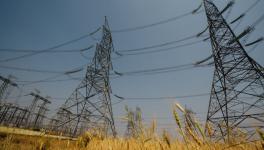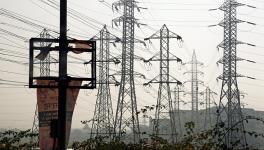Maharashtra's Saur Vahini Scheme Back on Track, But Still has a Long Way to Go
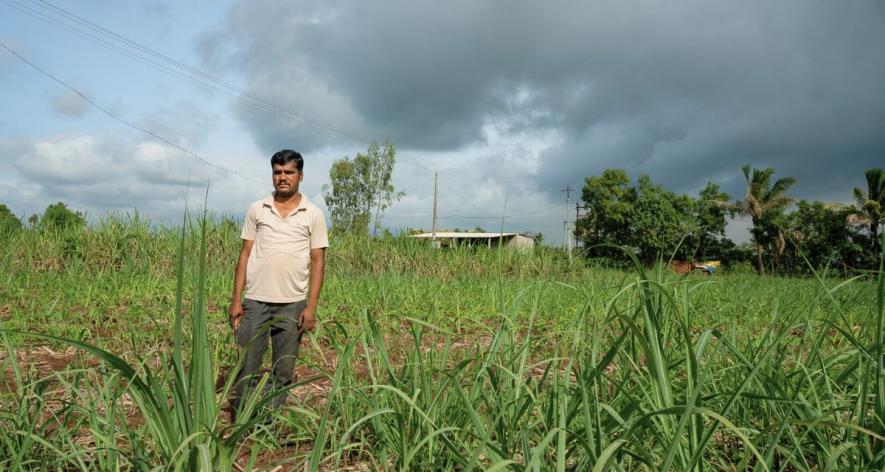
Nivrutti Koli, age 34 stands in his field and states that he has less land holding and requires less water to irrigate his entire field (Photo - Abhijeet Gurjar, 101Reporters).
Kolhapur, Maharashtra: “There is enough water in our wells to irrigate crops. But what can we do if the power supply is so erratic? We have forgotten our daily routine and are following only the routine of power availability,” frets Kamdev Pujari (59), while waiting for the water to reach the farther end of his 10-acre sugarcane field around midnight. Pujari hails from Kumbhoj in Hatkanangale taluka of Kolhapur.
“We have to work hard to irrigate every corner of the farm. We do not even have time to take care of our families,” adds Pujari, who broke his left hand in an accident some years ago after a dog chased his motorcycle during his midnight routine.
Across Maharashtra, power supply is available for agriculture connections on three nights (1 am to 9 am) and three days in a week for the last 23 years. Earlier, the supply was for 10 hours against the present eight hours for individual farmers. For cooperative irrigation societies, power should be available for 16 hours, but load shedding is cutting down their time too.
“I keep everything ready on the porch itself, else I will end up disturbing the sleep of my wife, sons and grandchildren. I sleep there and wake up at 1 am to head to the field to water the crops." he says. After work, he rests in a hut in the field until daybreak. This has been his routine for the last 23 years.
Kumbhoj received less rainfall this year, so by August farmers became dependent on power supply to pump water from the well. Unfortunately, load shedding proved a villain, making Pujari lose Rs 40,000 per acre of the crop.
Sachin Khot, an electric engineer by education, has 16 acres under sugarcane cultivation. He is also the secretary of a cooperative irrigation society at Rukadi in Hatkanangale block of Kolhapur. He claims that even the night supply is not continuous. “Power supply is disrupted several times, but we cannot call the electricity department or receive emergency help. As a result, we have to continuously change the irrigation cycle, which adversely affects the crop,” he complains.
Babalu Makandar, former zilla parishad member from Hatkanangale, says farmers put their lives at risk to bring water to the fields. “If there is an issue, he has to check the fuses, check wires with testers, put his hands into dangerous fuse boxes (DPs) and join broken cables. Five years ago. Ananda Powar, then aged 55, died after coming into contact with a broken cable. Sanjay Namdev Dhavale, then 44, was electrocuted while starting his motor pump,” he adds.
Breakdown of motor pumps is not uncommon, thanks to faulty or low-quality fuse boxes and electricity lines, low voltage, single phase and the altered amplitude of current that trips the pumps. Khot claims the farmers have to contribute to the repair as the department does not have funds for repair. “I have an automated drip irrigation system on my farmland, but I cannot sleep peacefully at night. I am fed up with this farmer’s life. I have decided that my only son will not pursue this job,” he adds.
The widening gap
Maharashtra is a leading state in industries that needs uninterrupted power supply. The demand-supply gap has pushed unorganised farmers to cope with night supply since 2000. In March, Maharashtra state had the highest demand of 28,000 MW, with the peak time varying from 11 am to 9 pm.
Maharashtra Electricity Consumers Federation president Prakash Hogade tells 101Reporters that individual farmers must get eight hours of uninterrupted power supply and cooperative irrigation societies should get 16 hours. There should not be load shedding in between.
Making their demand clear, the Kolhapur district unit of the state irrigation federation organised a protest on September 1, where federation secretary Vikrant Patil and farmers reiterated the need for continuous power supply.
If the farmers (mostly relatives) are using water from a common well, he cannot get any extra time to irrigate if his time slot is lost due to erratic power supply. Many times, electricity becomes the reason for disputes. As for irrigation societies, two motors are used for lifting water. If one of the motors is not running, then it becomes a problem as many times both the motors are on different DPs, a memorandum submitted to the irrigation department says.
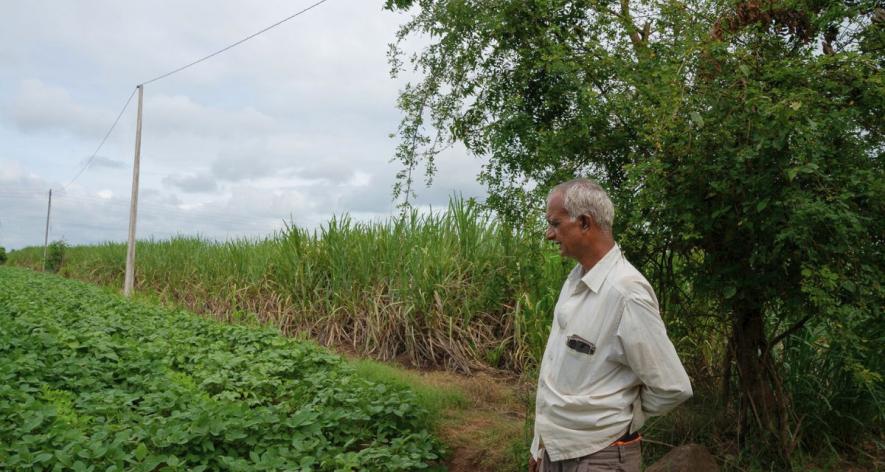
Kamdev Pujari, age 59 looking at his fields in the morning after doing the night shift of irrigation (Photo - Abhijeet Gurjar, 101Reporters)
To ease the situation, the Maharashtra government and its energy department has been trying its luck on solar projects. Accordingly, tenders have been invited from private companies to install solar projects with a Power Purchase Agreement (PPA), for which they have identified substations across the state. A 1 MW installation will cost Rs 3 to 4 crore, and the bidder private company will run and maintain the project for the next 25 years as per the PPA.
The government will facilitate land availability. Many village panchayats have reserved land, including gayran (grazing land), which can be used for the project. The private land can be leased at Rs 60,000 per acre for a year. If the panchayat allows the land, it will get a government incentive of Rs 5 lakh for up to three years. But they will not get the rent as the land belongs to the revenue department. Farmers who lease their private land for the project will benefit from a yearly rent of Rs 1.25 lakh per hectare.
Getting things on track
The Maharashtra government first launched the Mukhyamantri Krushi Saur Vahini in June 2017, as a solution to the prolonged demand of farmers for daytime power supply. There are 45 lakh agricultural consumers in the state. Of them, 30% are targeted to get solar-based electricity under the scheme to irrigate during daytime by 2025. It sorted many issues and launched a second version of the project in April this year.
An official statement from the Mahavitaran Energy Department states that 15 to 20 lakh farmers, which is 40 to 50% of the total agriculture related consumers, will benefit. So far, 550 MW of solar generation capacity has been commissioned under this scheme.
It seems like a humongous task to commission the remaining 6,450 MW within two years. According to a document, the private companies that win the tenders are struggling with finances as the government’s purchase rate in the PPA was too low, and price of components fluctuated a lot. Now, the purchase rate has been increased up to Rs 3.50 per unit.
Both the COVID-19 outbreak and the change in government affected the scheme’s progress. But after the BJP grabbed power again, Deputy Chief Minister Devendra Fadnavis relaunched it. Permissions and registration were hurdles during the last few years, but now a single-window system for registration is available.
The 11 kV/22 kV substations need to be able to transmit DC solar current to AC, but they were not equipped for it initially. To ensure better grid connectivity, the government has now infused Rs 682 crore. The land availability should be in the range of five to 10 km radius for the proposed solar substation. Land lease rent was low at Rs 30,000 per acre in the beginning, but it has been raised to Rs 60,000 this year.
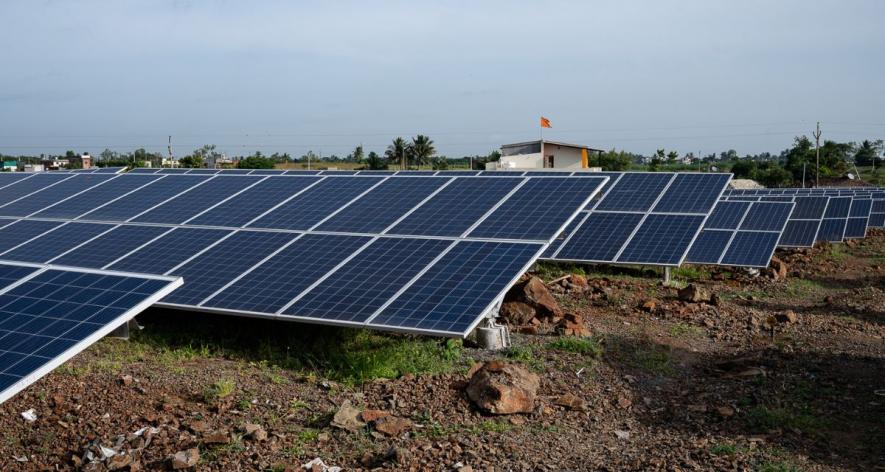
Solar Installations by TATA Solar Power of 4.4 MW at Kumbhoj, Hatkanagale taluka, Kolhapur over 18 hectares of land under MKSVY (Photo - Abhijeet Gurjar, 101Reporters)
To prevent further delays, the government has contracted 1,440 MW projects. Of this, 360 MW solar plants have been commissioned, while the rest are in the installation stage. A project takes at least a year to start production after successful bidding.
Approved projects suggest that 26% of the capacity will be installed in Nashik division, followed by Pune (23%), Amravati (22%), Aurangabad (19%) and Nagpur (11%) divisions. The programme envisages solarisation of 30% agricultural feeders by 2025, which translates into contracting solar power capacity of 7,000 MW by December 2025. Agriculture substation level solarisation will lead to daytime, reliable and better-quality supply between 8 am and 6 pm.
Benefits trickle down, challenges aplenty
Kolhapur district has 135 MW proposed solar projects under 46 substations spread across 12 talukas. Hatkanangale taluka was the first to get a 4.4 MW capacity agriculture solar feeder covering 18 acres of gayran land in Kumbhoj. The facility was inaugurated on August 4, and the people of the locality started getting benefits by September 14.
“We offered 18 acres of gram panchayat land to set up the feeder, which will help irrigate around 3,000 acres of jirayat (rain-fed land) and 5,000 acres of bagayat (dependent on wells/borewells) lands. Agriculture-based small industries such as dairy farms, poultry units and food processing businesses will also benefit,” says Kumbhoj deputy sarpanch Ajit Devmore.
Makandar, however, says it will be a challenge for the government to provide land. “Farmers in Kolhapur district have small land holdings and all cannot benefit from solar electricity," he says. Individual farmers cannot get an individual solar pump if the farmer has less land. To qualify for one hp solar pump, three acres of land are needed.
"Kolhapur's lands are so fertile that farmers will not want to spare even an inch of it. If the government successfully installs solar feeders, villages can benefit,” he says, adding that Gaganbavada, Chandgad, and Ajara talukas have plenty of mountain land that can be utilised. Meanwhile, land survey on 10 hectares of gayran land has faced stiff opposition from Kini villagers in Hatkanangale taluka. Not just in Kolhapur, acquisition will be an issue in the western districts of Sangli and Satara also.
(Abhijeet Gurjar is a Maharashtra-based freelance journalist and a member of 101Reporters, a pan-India network of grassroots reporters.)
Get the latest reports & analysis with people's perspective on Protests, movements & deep analytical videos, discussions of the current affairs in your Telegram app. Subscribe to NewsClick's Telegram channel & get Real-Time updates on stories, as they get published on our website.













